Criminology Assignment: Early Childhood Trauma and Violent Behavior
VerifiedAdded on 2022/11/29
|10
|2866
|89
Essay
AI Summary
This essay examines the significant impact of early childhood trauma on the development of violent behavior in offenders, drawing on various criminological studies and theories. It explores the different types of childhood trauma, including physical abuse, witnessing violence, sexual abuse, physical neglect, and emotional abuse, and their respective contributions to aggressive tendencies and criminal behavior. The essay discusses the psychological effects of these traumas, such as stress, lack of self-esteem, and impaired self-regulation, and how they can lead to antisocial behavior and violent crime. It also highlights the role of social learning theory in understanding how children learn violent behavior from their environment. The essay concludes that early childhood experiences, particularly negative ones, have a lasting influence on an individual's characteristics and actions, and that addressing childhood trauma is crucial in preventing violent crime. The essay references several studies, including those by Felitti et al., Aamodt, and Herrenkohl, to support its arguments, and it also considers the influence of factors such as gender differences in the context of childhood abuse and its consequences. The essay also discusses the impact of different types of abuse, including psychological abuse, and their impact on the development of aggression and criminal behavior.
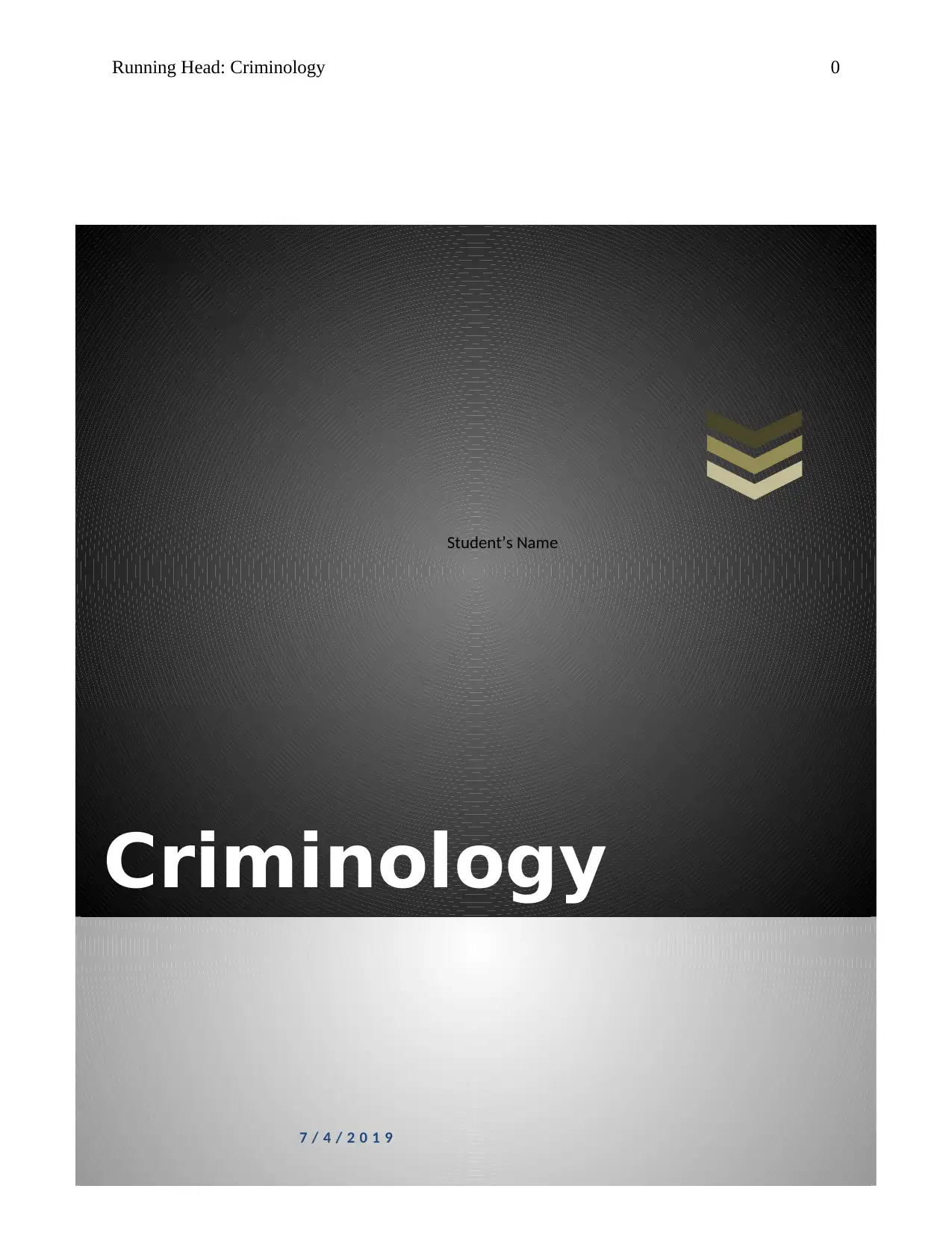
Criminology
Running Head: Criminology 0
7 / 4 / 2 0 1 9
Student’s Name
Running Head: Criminology 0
7 / 4 / 2 0 1 9
Student’s Name
Paraphrase This Document
Need a fresh take? Get an instant paraphrase of this document with our AI Paraphraser
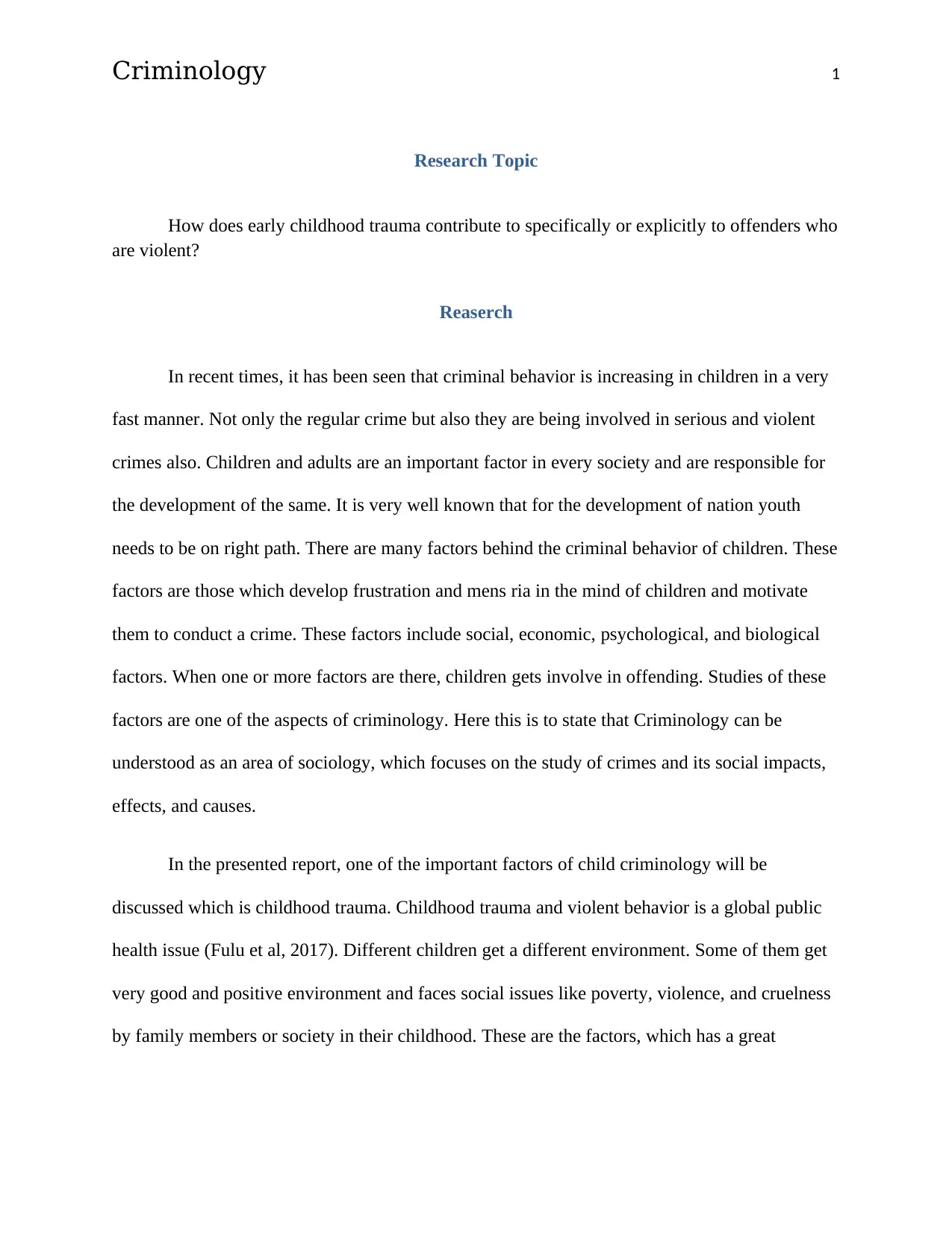
Criminology 1
Research Topic
How does early childhood trauma contribute to specifically or explicitly to offenders who
are violent?
Reaserch
In recent times, it has been seen that criminal behavior is increasing in children in a very
fast manner. Not only the regular crime but also they are being involved in serious and violent
crimes also. Children and adults are an important factor in every society and are responsible for
the development of the same. It is very well known that for the development of nation youth
needs to be on right path. There are many factors behind the criminal behavior of children. These
factors are those which develop frustration and mens ria in the mind of children and motivate
them to conduct a crime. These factors include social, economic, psychological, and biological
factors. When one or more factors are there, children gets involve in offending. Studies of these
factors are one of the aspects of criminology. Here this is to state that Criminology can be
understood as an area of sociology, which focuses on the study of crimes and its social impacts,
effects, and causes.
In the presented report, one of the important factors of child criminology will be
discussed which is childhood trauma. Childhood trauma and violent behavior is a global public
health issue (Fulu et al, 2017). Different children get a different environment. Some of them get
very good and positive environment and faces social issues like poverty, violence, and cruelness
by family members or society in their childhood. These are the factors, which has a great
Research Topic
How does early childhood trauma contribute to specifically or explicitly to offenders who
are violent?
Reaserch
In recent times, it has been seen that criminal behavior is increasing in children in a very
fast manner. Not only the regular crime but also they are being involved in serious and violent
crimes also. Children and adults are an important factor in every society and are responsible for
the development of the same. It is very well known that for the development of nation youth
needs to be on right path. There are many factors behind the criminal behavior of children. These
factors are those which develop frustration and mens ria in the mind of children and motivate
them to conduct a crime. These factors include social, economic, psychological, and biological
factors. When one or more factors are there, children gets involve in offending. Studies of these
factors are one of the aspects of criminology. Here this is to state that Criminology can be
understood as an area of sociology, which focuses on the study of crimes and its social impacts,
effects, and causes.
In the presented report, one of the important factors of child criminology will be
discussed which is childhood trauma. Childhood trauma and violent behavior is a global public
health issue (Fulu et al, 2017). Different children get a different environment. Some of them get
very good and positive environment and faces social issues like poverty, violence, and cruelness
by family members or society in their childhood. These are the factors, which has a great
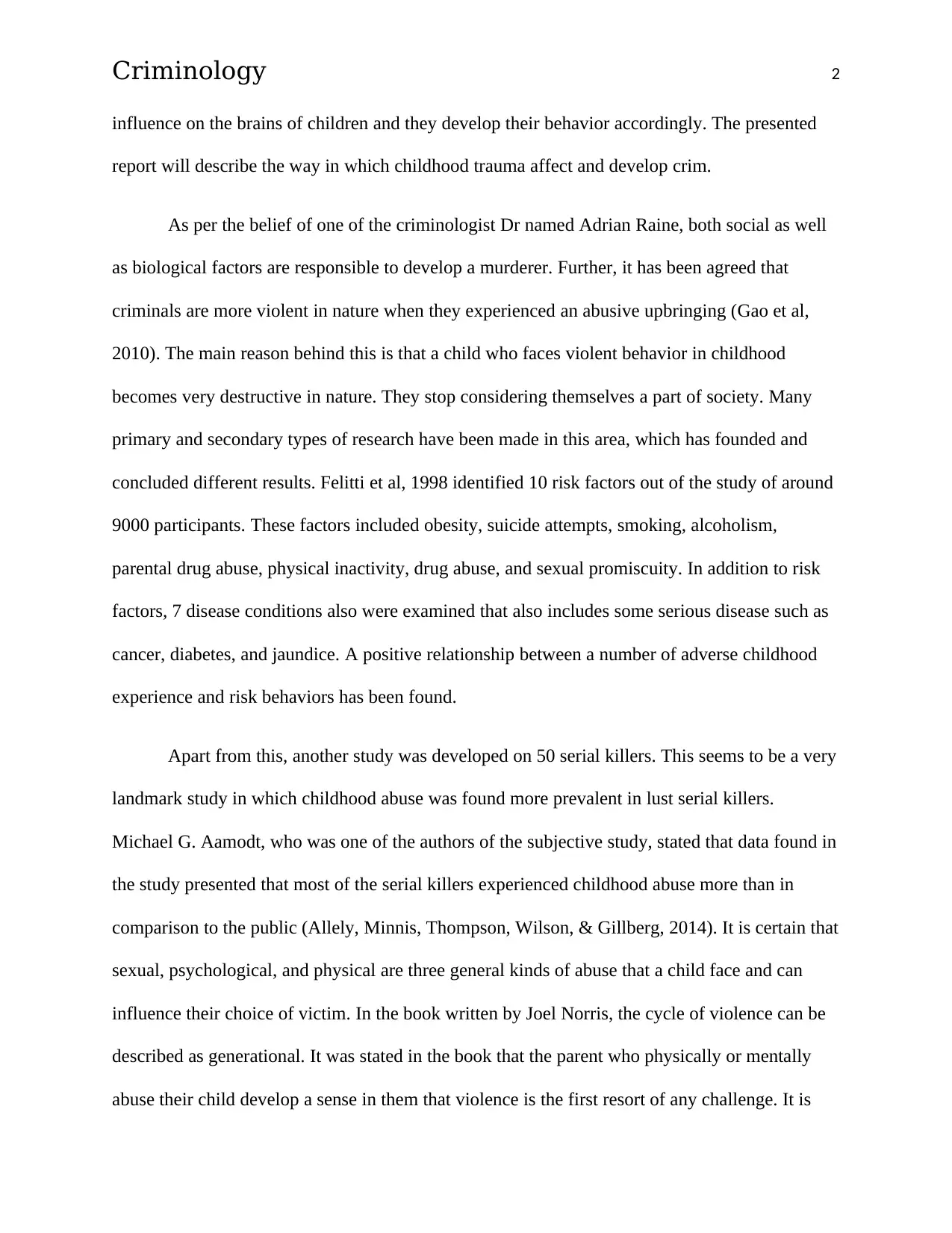
Criminology 2
influence on the brains of children and they develop their behavior accordingly. The presented
report will describe the way in which childhood trauma affect and develop crim.
As per the belief of one of the criminologist Dr named Adrian Raine, both social as well
as biological factors are responsible to develop a murderer. Further, it has been agreed that
criminals are more violent in nature when they experienced an abusive upbringing (Gao et al,
2010). The main reason behind this is that a child who faces violent behavior in childhood
becomes very destructive in nature. They stop considering themselves a part of society. Many
primary and secondary types of research have been made in this area, which has founded and
concluded different results. Felitti et al, 1998 identified 10 risk factors out of the study of around
9000 participants. These factors included obesity, suicide attempts, smoking, alcoholism,
parental drug abuse, physical inactivity, drug abuse, and sexual promiscuity. In addition to risk
factors, 7 disease conditions also were examined that also includes some serious disease such as
cancer, diabetes, and jaundice. A positive relationship between a number of adverse childhood
experience and risk behaviors has been found.
Apart from this, another study was developed on 50 serial killers. This seems to be a very
landmark study in which childhood abuse was found more prevalent in lust serial killers.
Michael G. Aamodt, who was one of the authors of the subjective study, stated that data found in
the study presented that most of the serial killers experienced childhood abuse more than in
comparison to the public (Allely, Minnis, Thompson, Wilson, & Gillberg, 2014). It is certain that
sexual, psychological, and physical are three general kinds of abuse that a child face and can
influence their choice of victim. In the book written by Joel Norris, the cycle of violence can be
described as generational. It was stated in the book that the parent who physically or mentally
abuse their child develop a sense in them that violence is the first resort of any challenge. It is
influence on the brains of children and they develop their behavior accordingly. The presented
report will describe the way in which childhood trauma affect and develop crim.
As per the belief of one of the criminologist Dr named Adrian Raine, both social as well
as biological factors are responsible to develop a murderer. Further, it has been agreed that
criminals are more violent in nature when they experienced an abusive upbringing (Gao et al,
2010). The main reason behind this is that a child who faces violent behavior in childhood
becomes very destructive in nature. They stop considering themselves a part of society. Many
primary and secondary types of research have been made in this area, which has founded and
concluded different results. Felitti et al, 1998 identified 10 risk factors out of the study of around
9000 participants. These factors included obesity, suicide attempts, smoking, alcoholism,
parental drug abuse, physical inactivity, drug abuse, and sexual promiscuity. In addition to risk
factors, 7 disease conditions also were examined that also includes some serious disease such as
cancer, diabetes, and jaundice. A positive relationship between a number of adverse childhood
experience and risk behaviors has been found.
Apart from this, another study was developed on 50 serial killers. This seems to be a very
landmark study in which childhood abuse was found more prevalent in lust serial killers.
Michael G. Aamodt, who was one of the authors of the subjective study, stated that data found in
the study presented that most of the serial killers experienced childhood abuse more than in
comparison to the public (Allely, Minnis, Thompson, Wilson, & Gillberg, 2014). It is certain that
sexual, psychological, and physical are three general kinds of abuse that a child face and can
influence their choice of victim. In the book written by Joel Norris, the cycle of violence can be
described as generational. It was stated in the book that the parent who physically or mentally
abuse their child develop a sense in them that violence is the first resort of any challenge. It is
⊘ This is a preview!⊘
Do you want full access?
Subscribe today to unlock all pages.

Trusted by 1+ million students worldwide
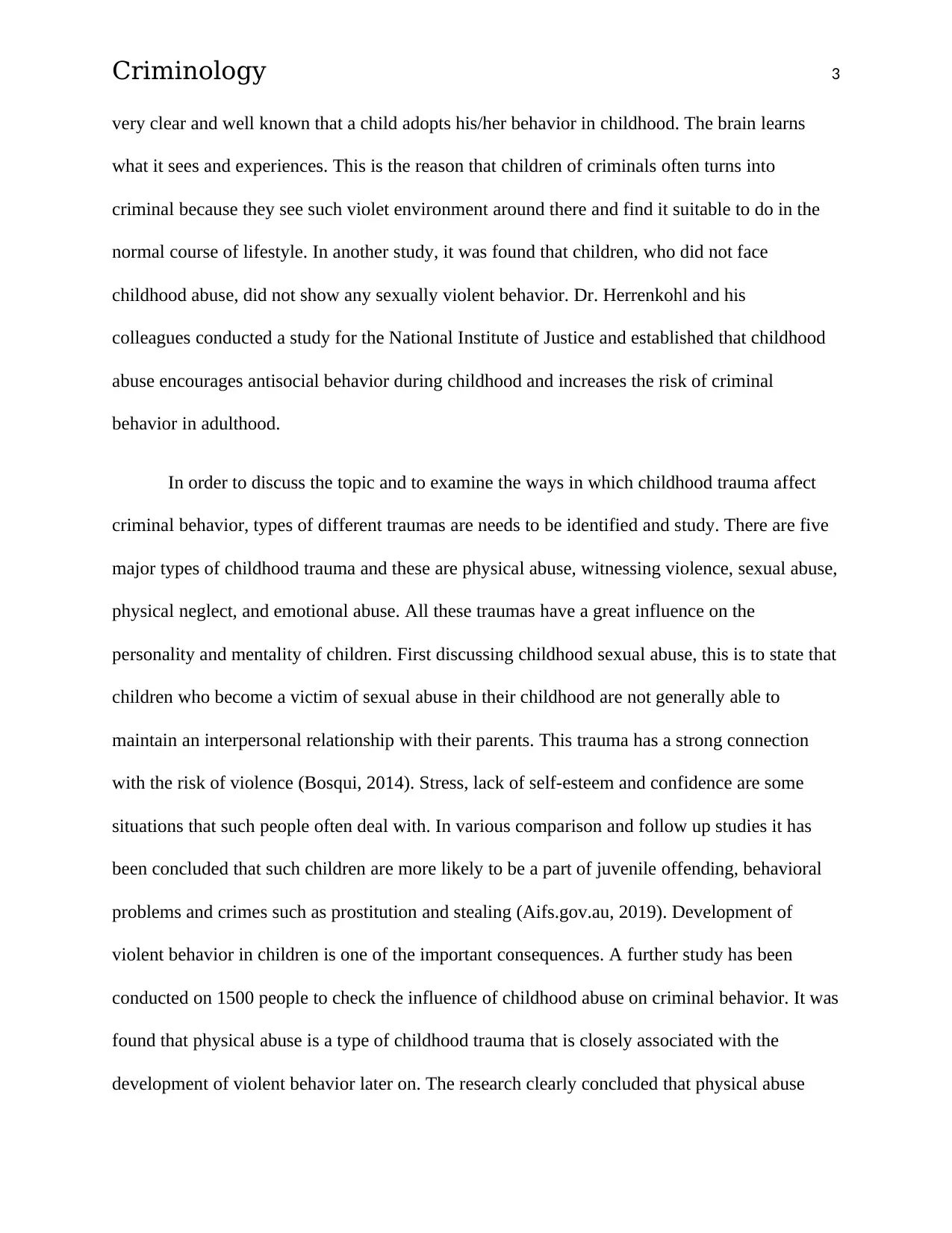
Criminology 3
very clear and well known that a child adopts his/her behavior in childhood. The brain learns
what it sees and experiences. This is the reason that children of criminals often turns into
criminal because they see such violet environment around there and find it suitable to do in the
normal course of lifestyle. In another study, it was found that children, who did not face
childhood abuse, did not show any sexually violent behavior. Dr. Herrenkohl and his
colleagues conducted a study for the National Institute of Justice and established that childhood
abuse encourages antisocial behavior during childhood and increases the risk of criminal
behavior in adulthood.
In order to discuss the topic and to examine the ways in which childhood trauma affect
criminal behavior, types of different traumas are needs to be identified and study. There are five
major types of childhood trauma and these are physical abuse, witnessing violence, sexual abuse,
physical neglect, and emotional abuse. All these traumas have a great influence on the
personality and mentality of children. First discussing childhood sexual abuse, this is to state that
children who become a victim of sexual abuse in their childhood are not generally able to
maintain an interpersonal relationship with their parents. This trauma has a strong connection
with the risk of violence (Bosqui, 2014). Stress, lack of self-esteem and confidence are some
situations that such people often deal with. In various comparison and follow up studies it has
been concluded that such children are more likely to be a part of juvenile offending, behavioral
problems and crimes such as prostitution and stealing (Aifs.gov.au, 2019). Development of
violent behavior in children is one of the important consequences. A further study has been
conducted on 1500 people to check the influence of childhood abuse on criminal behavior. It was
found that physical abuse is a type of childhood trauma that is closely associated with the
development of violent behavior later on. The research clearly concluded that physical abuse
very clear and well known that a child adopts his/her behavior in childhood. The brain learns
what it sees and experiences. This is the reason that children of criminals often turns into
criminal because they see such violet environment around there and find it suitable to do in the
normal course of lifestyle. In another study, it was found that children, who did not face
childhood abuse, did not show any sexually violent behavior. Dr. Herrenkohl and his
colleagues conducted a study for the National Institute of Justice and established that childhood
abuse encourages antisocial behavior during childhood and increases the risk of criminal
behavior in adulthood.
In order to discuss the topic and to examine the ways in which childhood trauma affect
criminal behavior, types of different traumas are needs to be identified and study. There are five
major types of childhood trauma and these are physical abuse, witnessing violence, sexual abuse,
physical neglect, and emotional abuse. All these traumas have a great influence on the
personality and mentality of children. First discussing childhood sexual abuse, this is to state that
children who become a victim of sexual abuse in their childhood are not generally able to
maintain an interpersonal relationship with their parents. This trauma has a strong connection
with the risk of violence (Bosqui, 2014). Stress, lack of self-esteem and confidence are some
situations that such people often deal with. In various comparison and follow up studies it has
been concluded that such children are more likely to be a part of juvenile offending, behavioral
problems and crimes such as prostitution and stealing (Aifs.gov.au, 2019). Development of
violent behavior in children is one of the important consequences. A further study has been
conducted on 1500 people to check the influence of childhood abuse on criminal behavior. It was
found that physical abuse is a type of childhood trauma that is closely associated with the
development of violent behavior later on. The research clearly concluded that physical abuse
Paraphrase This Document
Need a fresh take? Get an instant paraphrase of this document with our AI Paraphraser
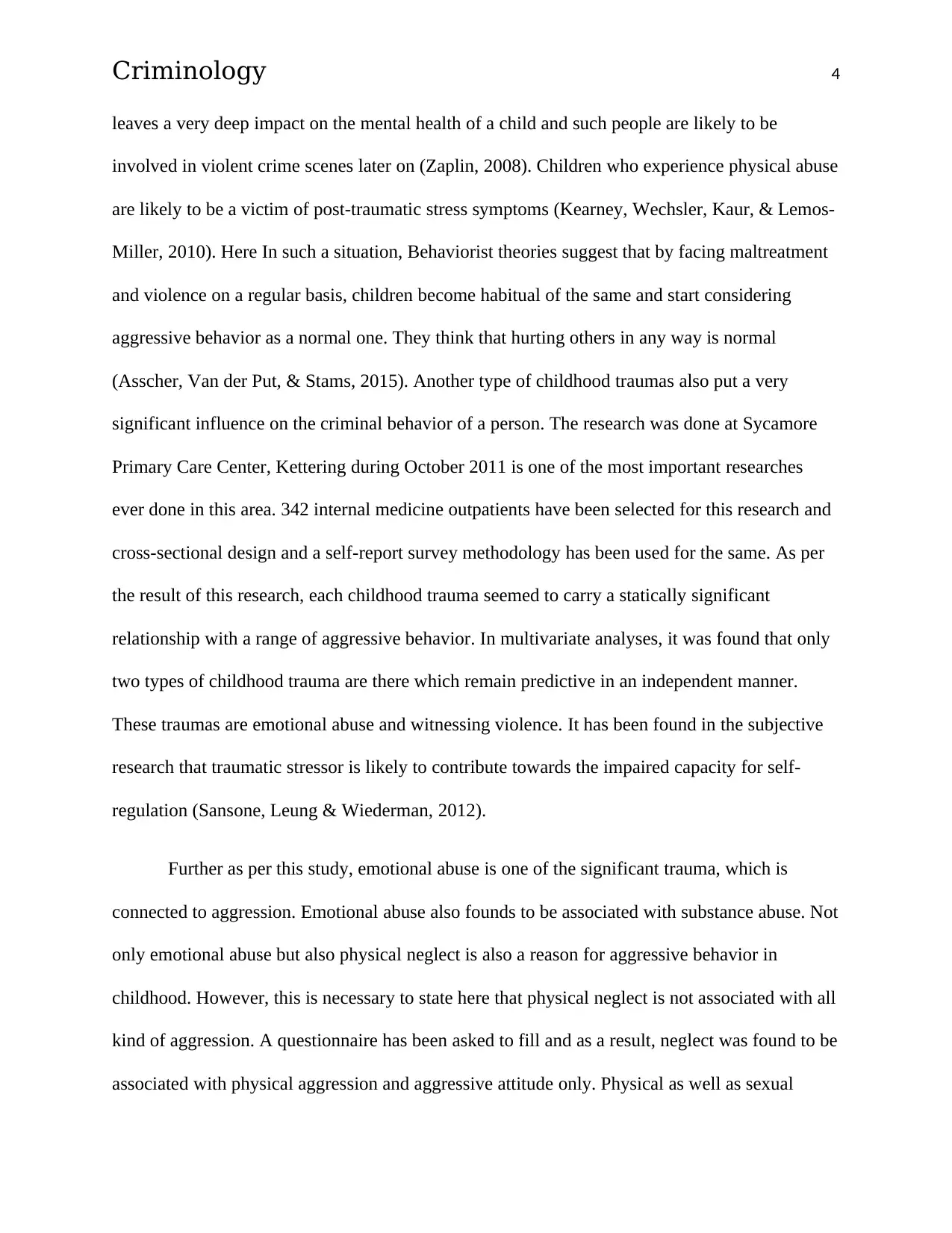
Criminology 4
leaves a very deep impact on the mental health of a child and such people are likely to be
involved in violent crime scenes later on (Zaplin, 2008). Children who experience physical abuse
are likely to be a victim of post-traumatic stress symptoms (Kearney, Wechsler, Kaur, & Lemos-
Miller, 2010). Here In such a situation, Behaviorist theories suggest that by facing maltreatment
and violence on a regular basis, children become habitual of the same and start considering
aggressive behavior as a normal one. They think that hurting others in any way is normal
(Asscher, Van der Put, & Stams, 2015). Another type of childhood traumas also put a very
significant influence on the criminal behavior of a person. The research was done at Sycamore
Primary Care Center, Kettering during October 2011 is one of the most important researches
ever done in this area. 342 internal medicine outpatients have been selected for this research and
cross-sectional design and a self-report survey methodology has been used for the same. As per
the result of this research, each childhood trauma seemed to carry a statically significant
relationship with a range of aggressive behavior. In multivariate analyses, it was found that only
two types of childhood trauma are there which remain predictive in an independent manner.
These traumas are emotional abuse and witnessing violence. It has been found in the subjective
research that traumatic stressor is likely to contribute towards the impaired capacity for self-
regulation (Sansone, Leung & Wiederman, 2012).
Further as per this study, emotional abuse is one of the significant trauma, which is
connected to aggression. Emotional abuse also founds to be associated with substance abuse. Not
only emotional abuse but also physical neglect is also a reason for aggressive behavior in
childhood. However, this is necessary to state here that physical neglect is not associated with all
kind of aggression. A questionnaire has been asked to fill and as a result, neglect was found to be
associated with physical aggression and aggressive attitude only. Physical as well as sexual
leaves a very deep impact on the mental health of a child and such people are likely to be
involved in violent crime scenes later on (Zaplin, 2008). Children who experience physical abuse
are likely to be a victim of post-traumatic stress symptoms (Kearney, Wechsler, Kaur, & Lemos-
Miller, 2010). Here In such a situation, Behaviorist theories suggest that by facing maltreatment
and violence on a regular basis, children become habitual of the same and start considering
aggressive behavior as a normal one. They think that hurting others in any way is normal
(Asscher, Van der Put, & Stams, 2015). Another type of childhood traumas also put a very
significant influence on the criminal behavior of a person. The research was done at Sycamore
Primary Care Center, Kettering during October 2011 is one of the most important researches
ever done in this area. 342 internal medicine outpatients have been selected for this research and
cross-sectional design and a self-report survey methodology has been used for the same. As per
the result of this research, each childhood trauma seemed to carry a statically significant
relationship with a range of aggressive behavior. In multivariate analyses, it was found that only
two types of childhood trauma are there which remain predictive in an independent manner.
These traumas are emotional abuse and witnessing violence. It has been found in the subjective
research that traumatic stressor is likely to contribute towards the impaired capacity for self-
regulation (Sansone, Leung & Wiederman, 2012).
Further as per this study, emotional abuse is one of the significant trauma, which is
connected to aggression. Emotional abuse also founds to be associated with substance abuse. Not
only emotional abuse but also physical neglect is also a reason for aggressive behavior in
childhood. However, this is necessary to state here that physical neglect is not associated with all
kind of aggression. A questionnaire has been asked to fill and as a result, neglect was found to be
associated with physical aggression and aggressive attitude only. Physical as well as sexual
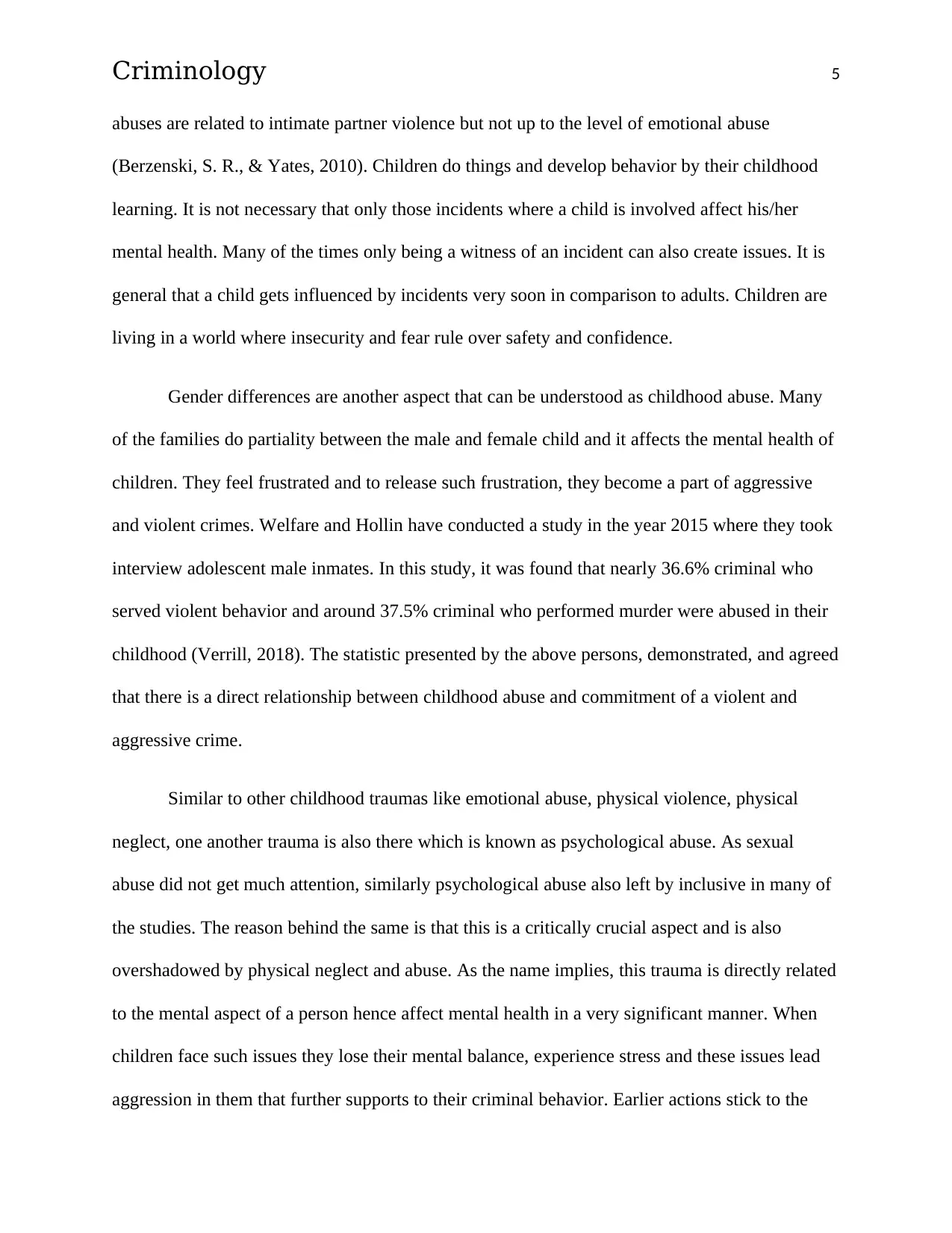
Criminology 5
abuses are related to intimate partner violence but not up to the level of emotional abuse
(Berzenski, S. R., & Yates, 2010). Children do things and develop behavior by their childhood
learning. It is not necessary that only those incidents where a child is involved affect his/her
mental health. Many of the times only being a witness of an incident can also create issues. It is
general that a child gets influenced by incidents very soon in comparison to adults. Children are
living in a world where insecurity and fear rule over safety and confidence.
Gender differences are another aspect that can be understood as childhood abuse. Many
of the families do partiality between the male and female child and it affects the mental health of
children. They feel frustrated and to release such frustration, they become a part of aggressive
and violent crimes. Welfare and Hollin have conducted a study in the year 2015 where they took
interview adolescent male inmates. In this study, it was found that nearly 36.6% criminal who
served violent behavior and around 37.5% criminal who performed murder were abused in their
childhood (Verrill, 2018). The statistic presented by the above persons, demonstrated, and agreed
that there is a direct relationship between childhood abuse and commitment of a violent and
aggressive crime.
Similar to other childhood traumas like emotional abuse, physical violence, physical
neglect, one another trauma is also there which is known as psychological abuse. As sexual
abuse did not get much attention, similarly psychological abuse also left by inclusive in many of
the studies. The reason behind the same is that this is a critically crucial aspect and is also
overshadowed by physical neglect and abuse. As the name implies, this trauma is directly related
to the mental aspect of a person hence affect mental health in a very significant manner. When
children face such issues they lose their mental balance, experience stress and these issues lead
aggression in them that further supports to their criminal behavior. Earlier actions stick to the
abuses are related to intimate partner violence but not up to the level of emotional abuse
(Berzenski, S. R., & Yates, 2010). Children do things and develop behavior by their childhood
learning. It is not necessary that only those incidents where a child is involved affect his/her
mental health. Many of the times only being a witness of an incident can also create issues. It is
general that a child gets influenced by incidents very soon in comparison to adults. Children are
living in a world where insecurity and fear rule over safety and confidence.
Gender differences are another aspect that can be understood as childhood abuse. Many
of the families do partiality between the male and female child and it affects the mental health of
children. They feel frustrated and to release such frustration, they become a part of aggressive
and violent crimes. Welfare and Hollin have conducted a study in the year 2015 where they took
interview adolescent male inmates. In this study, it was found that nearly 36.6% criminal who
served violent behavior and around 37.5% criminal who performed murder were abused in their
childhood (Verrill, 2018). The statistic presented by the above persons, demonstrated, and agreed
that there is a direct relationship between childhood abuse and commitment of a violent and
aggressive crime.
Similar to other childhood traumas like emotional abuse, physical violence, physical
neglect, one another trauma is also there which is known as psychological abuse. As sexual
abuse did not get much attention, similarly psychological abuse also left by inclusive in many of
the studies. The reason behind the same is that this is a critically crucial aspect and is also
overshadowed by physical neglect and abuse. As the name implies, this trauma is directly related
to the mental aspect of a person hence affect mental health in a very significant manner. When
children face such issues they lose their mental balance, experience stress and these issues lead
aggression in them that further supports to their criminal behavior. Earlier actions stick to the
⊘ This is a preview!⊘
Do you want full access?
Subscribe today to unlock all pages.

Trusted by 1+ million students worldwide
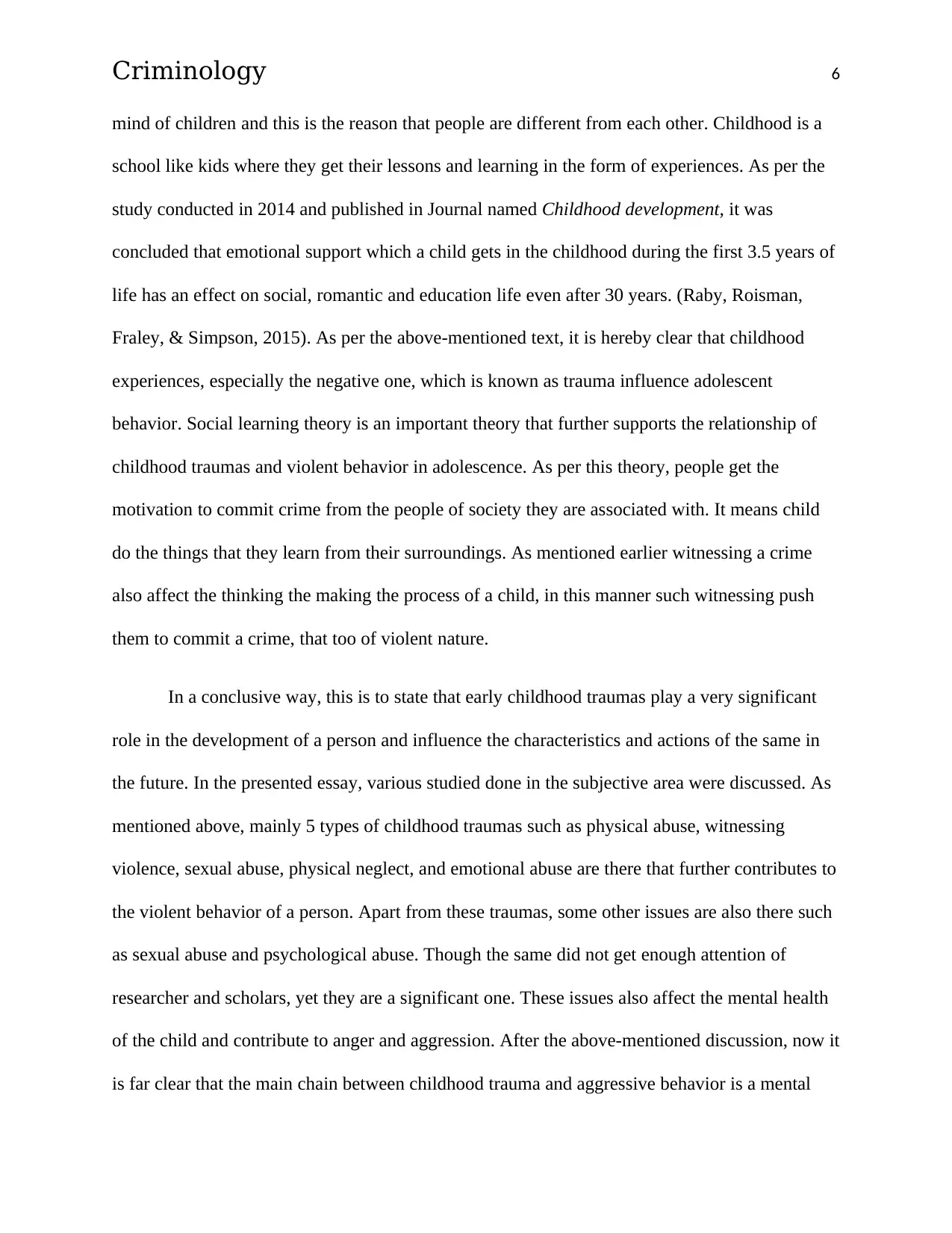
Criminology 6
mind of children and this is the reason that people are different from each other. Childhood is a
school like kids where they get their lessons and learning in the form of experiences. As per the
study conducted in 2014 and published in Journal named Childhood development, it was
concluded that emotional support which a child gets in the childhood during the first 3.5 years of
life has an effect on social, romantic and education life even after 30 years. (Raby, Roisman,
Fraley, & Simpson, 2015). As per the above-mentioned text, it is hereby clear that childhood
experiences, especially the negative one, which is known as trauma influence adolescent
behavior. Social learning theory is an important theory that further supports the relationship of
childhood traumas and violent behavior in adolescence. As per this theory, people get the
motivation to commit crime from the people of society they are associated with. It means child
do the things that they learn from their surroundings. As mentioned earlier witnessing a crime
also affect the thinking the making the process of a child, in this manner such witnessing push
them to commit a crime, that too of violent nature.
In a conclusive way, this is to state that early childhood traumas play a very significant
role in the development of a person and influence the characteristics and actions of the same in
the future. In the presented essay, various studied done in the subjective area were discussed. As
mentioned above, mainly 5 types of childhood traumas such as physical abuse, witnessing
violence, sexual abuse, physical neglect, and emotional abuse are there that further contributes to
the violent behavior of a person. Apart from these traumas, some other issues are also there such
as sexual abuse and psychological abuse. Though the same did not get enough attention of
researcher and scholars, yet they are a significant one. These issues also affect the mental health
of the child and contribute to anger and aggression. After the above-mentioned discussion, now it
is far clear that the main chain between childhood trauma and aggressive behavior is a mental
mind of children and this is the reason that people are different from each other. Childhood is a
school like kids where they get their lessons and learning in the form of experiences. As per the
study conducted in 2014 and published in Journal named Childhood development, it was
concluded that emotional support which a child gets in the childhood during the first 3.5 years of
life has an effect on social, romantic and education life even after 30 years. (Raby, Roisman,
Fraley, & Simpson, 2015). As per the above-mentioned text, it is hereby clear that childhood
experiences, especially the negative one, which is known as trauma influence adolescent
behavior. Social learning theory is an important theory that further supports the relationship of
childhood traumas and violent behavior in adolescence. As per this theory, people get the
motivation to commit crime from the people of society they are associated with. It means child
do the things that they learn from their surroundings. As mentioned earlier witnessing a crime
also affect the thinking the making the process of a child, in this manner such witnessing push
them to commit a crime, that too of violent nature.
In a conclusive way, this is to state that early childhood traumas play a very significant
role in the development of a person and influence the characteristics and actions of the same in
the future. In the presented essay, various studied done in the subjective area were discussed. As
mentioned above, mainly 5 types of childhood traumas such as physical abuse, witnessing
violence, sexual abuse, physical neglect, and emotional abuse are there that further contributes to
the violent behavior of a person. Apart from these traumas, some other issues are also there such
as sexual abuse and psychological abuse. Though the same did not get enough attention of
researcher and scholars, yet they are a significant one. These issues also affect the mental health
of the child and contribute to anger and aggression. After the above-mentioned discussion, now it
is far clear that the main chain between childhood trauma and aggressive behavior is a mental
Paraphrase This Document
Need a fresh take? Get an instant paraphrase of this document with our AI Paraphraser
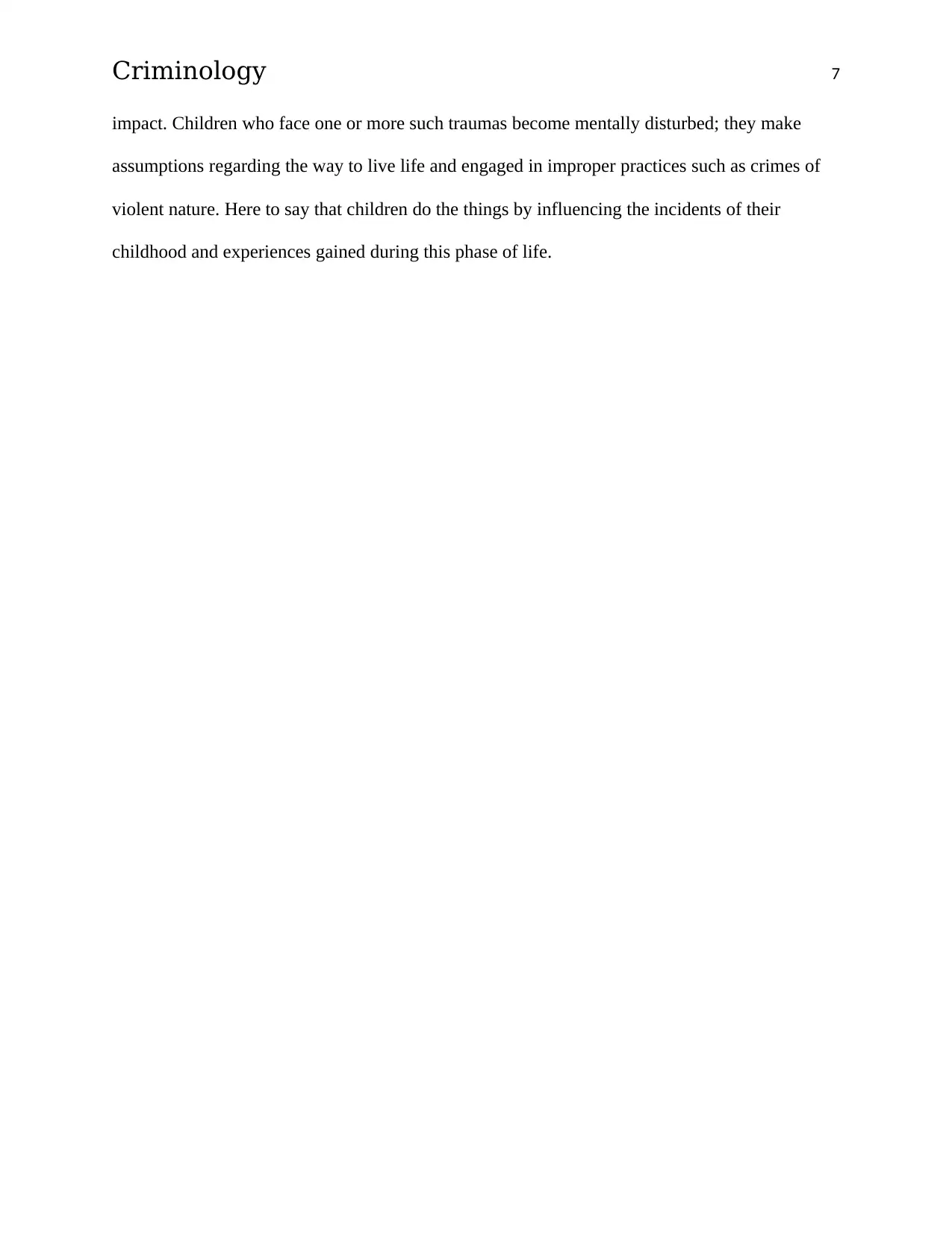
Criminology 7
impact. Children who face one or more such traumas become mentally disturbed; they make
assumptions regarding the way to live life and engaged in improper practices such as crimes of
violent nature. Here to say that children do the things by influencing the incidents of their
childhood and experiences gained during this phase of life.
impact. Children who face one or more such traumas become mentally disturbed; they make
assumptions regarding the way to live life and engaged in improper practices such as crimes of
violent nature. Here to say that children do the things by influencing the incidents of their
childhood and experiences gained during this phase of life.
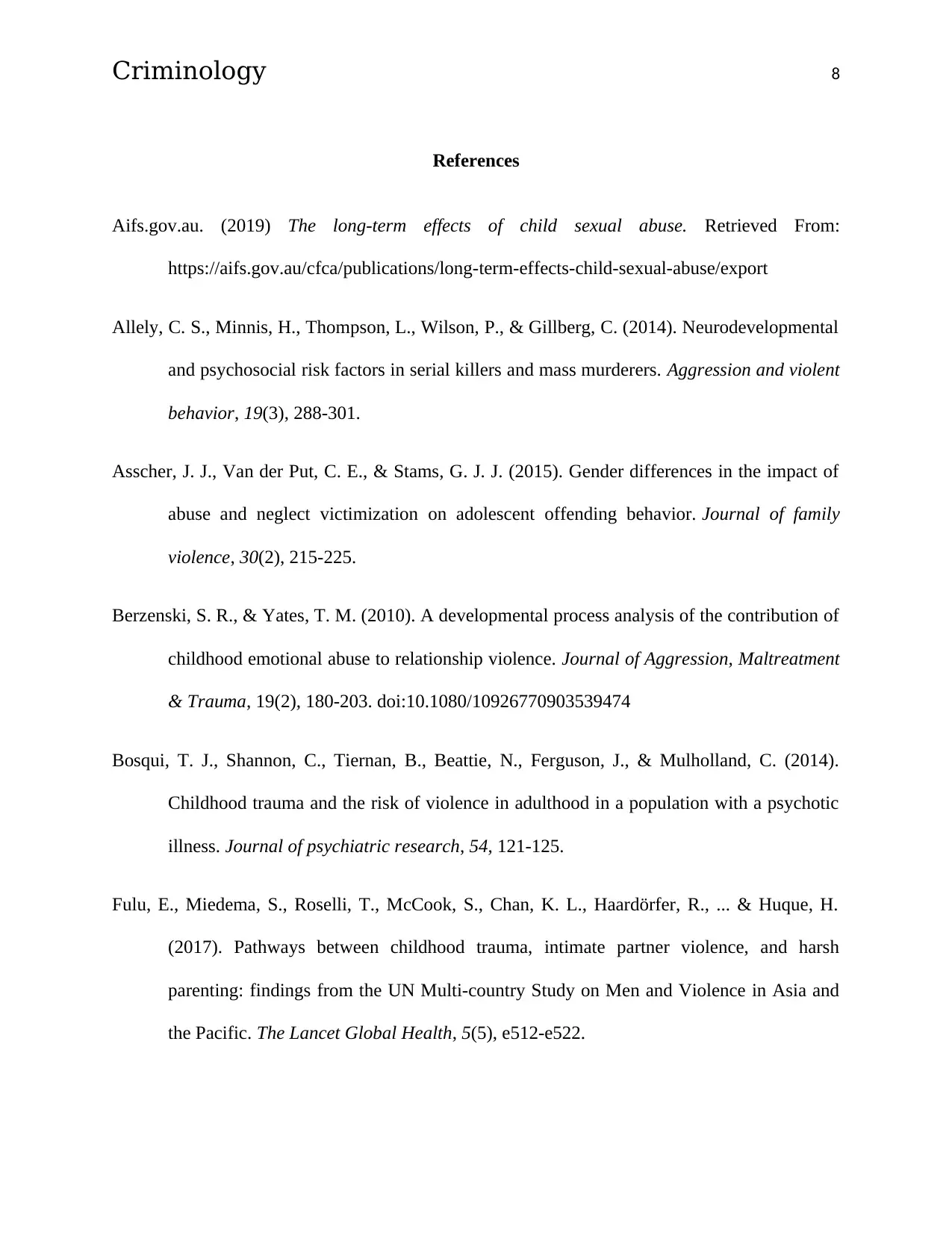
Criminology 8
References
Aifs.gov.au. (2019) The long-term effects of child sexual abuse. Retrieved From:
https://aifs.gov.au/cfca/publications/long-term-effects-child-sexual-abuse/export
Allely, C. S., Minnis, H., Thompson, L., Wilson, P., & Gillberg, C. (2014). Neurodevelopmental
and psychosocial risk factors in serial killers and mass murderers. Aggression and violent
behavior, 19(3), 288-301.
Asscher, J. J., Van der Put, C. E., & Stams, G. J. J. (2015). Gender differences in the impact of
abuse and neglect victimization on adolescent offending behavior. Journal of family
violence, 30(2), 215-225.
Berzenski, S. R., & Yates, T. M. (2010). A developmental process analysis of the contribution of
childhood emotional abuse to relationship violence. Journal of Aggression, Maltreatment
& Trauma, 19(2), 180-203. doi:10.1080/10926770903539474
Bosqui, T. J., Shannon, C., Tiernan, B., Beattie, N., Ferguson, J., & Mulholland, C. (2014).
Childhood trauma and the risk of violence in adulthood in a population with a psychotic
illness. Journal of psychiatric research, 54, 121-125.
Fulu, E., Miedema, S., Roselli, T., McCook, S., Chan, K. L., Haardörfer, R., ... & Huque, H.
(2017). Pathways between childhood trauma, intimate partner violence, and harsh
parenting: findings from the UN Multi-country Study on Men and Violence in Asia and
the Pacific. The Lancet Global Health, 5(5), e512-e522.
References
Aifs.gov.au. (2019) The long-term effects of child sexual abuse. Retrieved From:
https://aifs.gov.au/cfca/publications/long-term-effects-child-sexual-abuse/export
Allely, C. S., Minnis, H., Thompson, L., Wilson, P., & Gillberg, C. (2014). Neurodevelopmental
and psychosocial risk factors in serial killers and mass murderers. Aggression and violent
behavior, 19(3), 288-301.
Asscher, J. J., Van der Put, C. E., & Stams, G. J. J. (2015). Gender differences in the impact of
abuse and neglect victimization on adolescent offending behavior. Journal of family
violence, 30(2), 215-225.
Berzenski, S. R., & Yates, T. M. (2010). A developmental process analysis of the contribution of
childhood emotional abuse to relationship violence. Journal of Aggression, Maltreatment
& Trauma, 19(2), 180-203. doi:10.1080/10926770903539474
Bosqui, T. J., Shannon, C., Tiernan, B., Beattie, N., Ferguson, J., & Mulholland, C. (2014).
Childhood trauma and the risk of violence in adulthood in a population with a psychotic
illness. Journal of psychiatric research, 54, 121-125.
Fulu, E., Miedema, S., Roselli, T., McCook, S., Chan, K. L., Haardörfer, R., ... & Huque, H.
(2017). Pathways between childhood trauma, intimate partner violence, and harsh
parenting: findings from the UN Multi-country Study on Men and Violence in Asia and
the Pacific. The Lancet Global Health, 5(5), e512-e522.
⊘ This is a preview!⊘
Do you want full access?
Subscribe today to unlock all pages.

Trusted by 1+ million students worldwide
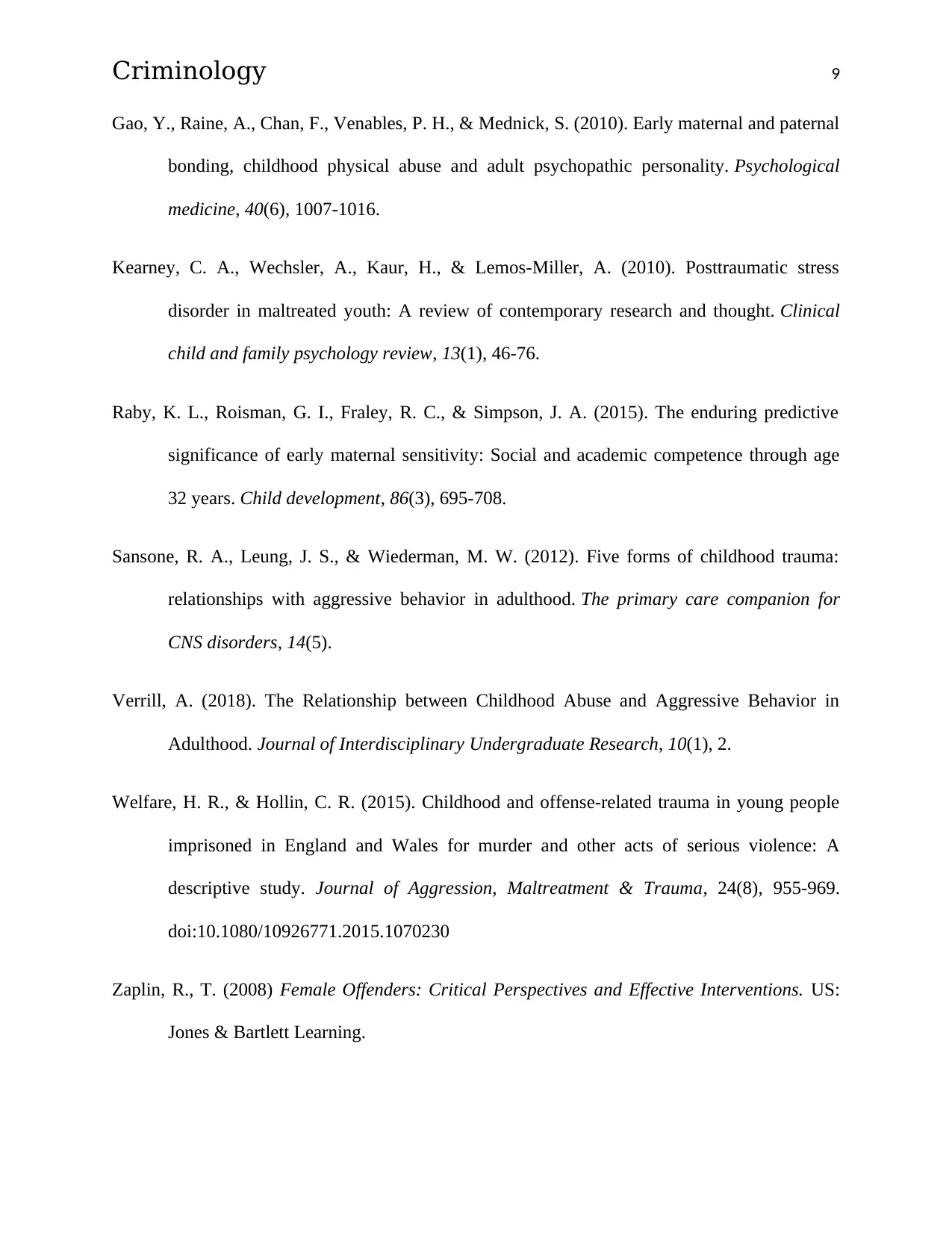
Criminology 9
Gao, Y., Raine, A., Chan, F., Venables, P. H., & Mednick, S. (2010). Early maternal and paternal
bonding, childhood physical abuse and adult psychopathic personality. Psychological
medicine, 40(6), 1007-1016.
Kearney, C. A., Wechsler, A., Kaur, H., & Lemos-Miller, A. (2010). Posttraumatic stress
disorder in maltreated youth: A review of contemporary research and thought. Clinical
child and family psychology review, 13(1), 46-76.
Raby, K. L., Roisman, G. I., Fraley, R. C., & Simpson, J. A. (2015). The enduring predictive
significance of early maternal sensitivity: Social and academic competence through age
32 years. Child development, 86(3), 695-708.
Sansone, R. A., Leung, J. S., & Wiederman, M. W. (2012). Five forms of childhood trauma:
relationships with aggressive behavior in adulthood. The primary care companion for
CNS disorders, 14(5).
Verrill, A. (2018). The Relationship between Childhood Abuse and Aggressive Behavior in
Adulthood. Journal of Interdisciplinary Undergraduate Research, 10(1), 2.
Welfare, H. R., & Hollin, C. R. (2015). Childhood and offense-related trauma in young people
imprisoned in England and Wales for murder and other acts of serious violence: A
descriptive study. Journal of Aggression, Maltreatment & Trauma, 24(8), 955-969.
doi:10.1080/10926771.2015.1070230
Zaplin, R., T. (2008) Female Offenders: Critical Perspectives and Effective Interventions. US:
Jones & Bartlett Learning.
Gao, Y., Raine, A., Chan, F., Venables, P. H., & Mednick, S. (2010). Early maternal and paternal
bonding, childhood physical abuse and adult psychopathic personality. Psychological
medicine, 40(6), 1007-1016.
Kearney, C. A., Wechsler, A., Kaur, H., & Lemos-Miller, A. (2010). Posttraumatic stress
disorder in maltreated youth: A review of contemporary research and thought. Clinical
child and family psychology review, 13(1), 46-76.
Raby, K. L., Roisman, G. I., Fraley, R. C., & Simpson, J. A. (2015). The enduring predictive
significance of early maternal sensitivity: Social and academic competence through age
32 years. Child development, 86(3), 695-708.
Sansone, R. A., Leung, J. S., & Wiederman, M. W. (2012). Five forms of childhood trauma:
relationships with aggressive behavior in adulthood. The primary care companion for
CNS disorders, 14(5).
Verrill, A. (2018). The Relationship between Childhood Abuse and Aggressive Behavior in
Adulthood. Journal of Interdisciplinary Undergraduate Research, 10(1), 2.
Welfare, H. R., & Hollin, C. R. (2015). Childhood and offense-related trauma in young people
imprisoned in England and Wales for murder and other acts of serious violence: A
descriptive study. Journal of Aggression, Maltreatment & Trauma, 24(8), 955-969.
doi:10.1080/10926771.2015.1070230
Zaplin, R., T. (2008) Female Offenders: Critical Perspectives and Effective Interventions. US:
Jones & Bartlett Learning.
1 out of 10
Related Documents
Your All-in-One AI-Powered Toolkit for Academic Success.
+13062052269
info@desklib.com
Available 24*7 on WhatsApp / Email
![[object Object]](/_next/static/media/star-bottom.7253800d.svg)
Unlock your academic potential
Copyright © 2020–2025 A2Z Services. All Rights Reserved. Developed and managed by ZUCOL.


